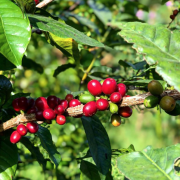The world's ninth largest coffee exporter-Mexico coffee producing coffee bean characteristics History story
The vast majority (90 per cent) of Mexico's coffee beans come from four states in the southern half of the country: Chiapas (44 per cent), Oaxaca (11 per cent), Veracruz (29 per cent) and Puebla (11 per cent) (source: SIAP 2013). More than 500000 farmers grow coffee, of which about 70 per cent are small farmers with less than 10 hectares of land. Large estates are rare-only 0.06 per cent of farms are larger than 50 hectares. [source: Amecaf é, August 2012].

Nearly 97 per cent of Mexico's production is Arabica coffee, most of which are traditional varieties such as Garnica, Typica and Bourbon. However, this situation is changing due to the influence of coffee leaf rust, and many manufacturers are introducing Catimor strains to combat the effects of fungi. Some of them, such as Marsellesa, can provide good cup quality and increase production and disease resistance. It is too early, but despite recent losses, many manufacturers are taking positive steps. The plant is grown in 16 states in Mexico, but most of it is distributed in 711000 hectares (2018 data) in the south of the country.

Coffee first appeared in the late 18th century, when it grew up on European farms, mainly Mexican indigenous workers. A revolution that took place at the beginning of the 20th century began the process of changing the status quo through land reform.
Today, Mexican farms are very different from the large plantations of the past: the recent agricultural census recorded 515000 producers, 85 per cent of whom were indigenous Mexicans and 95 per cent of the acreage was less than 3 hectares. Small and indigenous producers are the most vulnerable in the coffee industry as a whole, although the Government of Mexico is working with the National Institute of Indigenous Peoples (INPI) to support them. Most of Mexico's production is organized through cooperatives. It is also worth noting that Mexico is one of the world's largest exporters of organically certified coffee, with as many as 8 per cent of producers growing the coffee, according to the Ministry of Agriculture and Rural Development (SADER). These facts are relevant, but to understand why, it is necessary to go back nearly 40 years.
In 1973, the Mexican government recognized the potential of coffee in helping rural development and established the National Coffee Institute INMECAFE. Ten years later, coffee became Mexico's most valuable export crop, accounting for 35% of total agricultural production by the mid-1980s. Production peaked, with raw coffee production exceeding 440000 tons in 1990. The collapse of the international coffee agreement abolished the minimum price of coffee, and eventually INMECAFE shut down. Instead, cooperatives not only support indigenous producers in Mexico, but also encourage the production of organic coffee.
Mexico exported 2.6 million 60-kilogram bags in 2018. Although it accounts for less than 1% of global coffee exports, it still makes the country the world's ninth-largest coffee exporter.
Important Notice :
前街咖啡 FrontStreet Coffee has moved to new addredd:
FrontStreet Coffee Address: 315,Donghua East Road,GuangZhou
Tel:020 38364473
- Prev

Why is there no oil in hand-brewed coffee? what is coffee oil? Why do coffee beans produce oil?
Why is there no fat in hand-brewed coffee? are the beans not fresh? Recently, I saw such a topic of discussion in the front street. Hand-brewed coffee is not really free of fat, although it is inconspicuous, it will be reflected in the taste. What is coffee fat? When it comes to coffee grease, the first thing that comes to mind is the golden grease layer on espresso, but in drip coffee or soaked coffee
- Next

Mexican Coffee Flavor characteristics Historical Story Fine Coffee Development Mexican Coffee Industry is facing crisis
Mexico is often excluded when people list famous coffee producing areas. There's no Mexican coffee on the bean list on the front street. But there is no denying that Mexican coffee has many advantages: unique fruity characteristics, positive social and environmental impacts and rich traditions of coffee production. Coffee first arrived in Mexico in the late 1700s and was settled by Spain
Related
- Detailed explanation of Jadeite planting Land in Panamanian Jadeite Manor introduction to the grading system of Jadeite competitive bidding, Red bid, Green bid and Rose Summer
- Story of Coffee planting in Brenka region of Costa Rica Stonehenge Manor anaerobic heavy honey treatment of flavor mouth
- What's on the barrel of Blue Mountain Coffee beans?
- Can American coffee also pull flowers? How to use hot American style to pull out a good-looking pattern?
- Can you make a cold extract with coffee beans? What is the right proportion for cold-extracted coffee formula?
- Indonesian PWN Gold Mandrine Coffee Origin Features Flavor How to Chong? Mandolin coffee is American.
- A brief introduction to the flavor characteristics of Brazilian yellow bourbon coffee beans
- What is the effect of different water quality on the flavor of cold-extracted coffee? What kind of water is best for brewing coffee?
- Why do you think of Rose Summer whenever you mention Panamanian coffee?
- Introduction to the characteristics of authentic blue mountain coffee bean producing areas? What is the CIB Coffee Authority in Jamaica?

